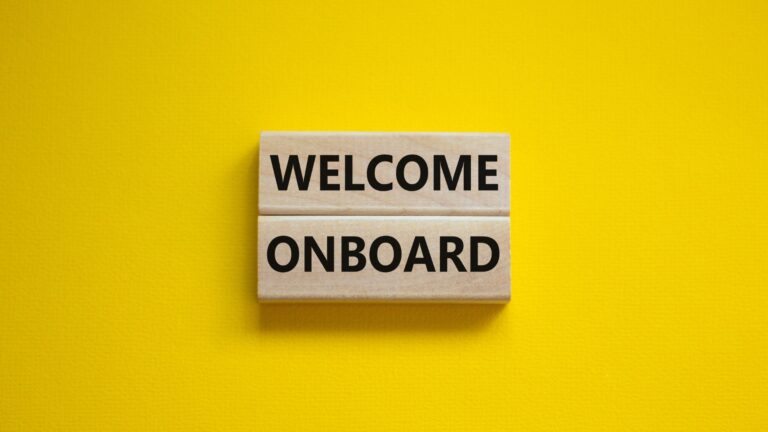Key Takeaways
- A great onboarding process can improve new hire retention by up to 82%.
- Several mandatory documents, such as W-4 and I-9 forms, must be provided to employees for legal and tax reasons.
- Additional onboarding documents, such as employee handbooks and brand guidelines, help employees understand what’s expected of them. They also help quickly get them up to speed.
- Onboarding is significantly more efficient and easier for both managers and employees when you use a digital onboarding tool.
Introduction
The goal of onboarding is to help new employees feel welcome, informed, and ready to hit the ground running. By making the process straightforward, fun, and informative, you’ll set the stage for a long and successful relationship with your new team members.
A big part of efficient employee onboarding is providing the right documentation.
In this article, I discuss the importance of onboarding documents in the onboarding process and run down the 14 documents you must give to new hires.
Why Is a Good Onboarding Process Important?
A good onboarding process is essential for your business because it helps new hires feel welcome and makes it easier to transition into their new positions.
When new employees have a positive onboarding experience, employee engagement also improves. Staff are more likely to feel committed to their job, which can lead to better performance and increased retention rates.
In fact, a 2015 study by Brandon Hall Group found that organizations with a strong onboarding process have an 82% better employee retention rate.
Streamlining onboarding documents is an important part of the process. By providing new hire paperwork with clear and concise information about the role, benefits, and company policies, you help employees quickly get up to speed and feel confident in their new position.
This reduces confusion, saves time, and allows for a smoother transition and better productivity. It’s beneficial both for the new employee and your organization as a whole!
What Are Onboarding Documents?
Onboarding documents provide important information that sets your new team members up for success. They also help you meet government requirements.
Below, I’ve outlined the most important onboarding documents, separated into 4 sections. Keep in mind that whether you’re conducting virtual onboarding or in-person onboarding, you’ll need to determine a system to collect, store, and organize everyone’s documents.
Legal and Tax Forms
These are mandatory and required by the state or federal government. These include documents like W-4 and I-9 forms, which must be completed within days of an employee’s start date to avoid fines or penalties.
Company-Specific Documents
These cover all the information an employee should know, regardless of their position. These include employee handbooks, organizational charts, and mission statements.
Role-Specific Documents
These detail your expectations of your new employee and provide standard operating procedures (SOPs) and policy and procedure manuals.
Pay and Benefits Documents
These educate your employees on how they’ll be paid and what benefits they can take advantage of. They also provide workers with the information they need to take advantage of benefits. This category could include health benefit packets, 401k information, time-off policies, stock option documents, and more.
For more information, read Connecteam’s onboarding checklist template.
14 Essential Onboarding Documents
Now that you’re up to speed on what onboarding documents are, let’s discuss the 14 most essential documents to provide new hires.
Legal and Tax Onboarding Documents
W-4 form
It’s important to provide new employees with a W-4 federal income tax form that allows them to adjust their tax withholding status. It’s your responsibility to keep track of each employee’s most recent W-4 form and ensure that their paychecks reflect their updated withholding choices.
To comply with regulations, you must keep these tax documents on file for each employee for at least 4 years after the date the employment tax is due or paid, whichever is later.
By staying organized and keeping accurate records, you can ensure that your business complies with the law and that your employees are paid accurately.
I-9 form
The employment I-9 form is an important document used to verify a new hire’s eligibility to work in the United States.
As an employer, it’s your responsibility to ensure that your new hire is legally authorized to work in the country based on their citizenship, visa, resident, and immigration status. I-9 forms are required for citizens and non-citizens.
The I-9 process involves two essential steps:
- The new hire must fill out a form declaring their eligibility and the documents that can be used to verify their status.
- The new hire must submit work eligibility documents that the employer must review. Typically, a company’s human resources department will verify whether the documents meet the IRS’s list of acceptable documents. These documents could be passports, birth certificates, or permanent resident cards, for instance.
Once you’ve verified the new hire’s citizenship, they can begin working for your company.
You don’t need to submit the employment I-9 form or verifying documents, but you must have them available if requested by an immigration officer.
Forms for state taxes
Some states have essential tax withholding forms. You should check with your local government to see if you need employees to complete this onboarding paperwork.
As it stands, 31 states require a state tax withholding certificate. These are:
- Alabama
- Arizona
- Arkansas
- California
- Connecticut
- District of Columbia
- Georgia
- Hawaii
- Illinois
- Indiana
- Iowa
- Kansas
- Kentucky
- Louisiana
- Maine
- Maryland
- Massachusetts
- Michigan
- Mississippi
- Missouri
- New Jersey
- New York
- Ohio
- Oklahoma
- Oregon
- Pennsylvania
- Rhode Island
- Vermont
- Virginia
- West Virginia
- Wisconsin
Drug testing and background checks
You must include a copy of your drug testing policy in your onboarding paperwork if your company requires drug testing.
It’s also important to keep records of test results and background checks to comply with governmental or industry regulations.
My advice: Using a digital online employee management system with support for custom forms and document uploading means you can keep all your company’s employee files in one place.
Connecteam allows employees to fill in their W-4, I-9, and other details from anywhere. This can help streamline and simplify your onboarding processes. Sign up for a free trial to test these features and more.
Company Onboarding Documents
Non-compete agreement contract
Non-compete agreements prohibit employees from working for competitors or starting similar businesses for a specified period after leaving your company, such as 6 months.
These agreements can be useful for companies that invest a significant amount of resources in developing proprietary information or customer relationships that are critical to their success.
Additionally, non-compete agreements can help companies retain a competitive advantage by preventing former employees from sharing their knowledge and expertise with competitors. They can also help avoid conflicts of interest. These agreements help ensure that employees focus on their current job responsibilities and don’t use their position within the company to benefit a competing business.
Emergency contact form
Having an emergency contact form for employees is an essential part of any company’s risk management plan. The form allows your company to quickly and easily get in touch with an employee’s designated emergency contact in case of an emergency or accident.
Having an emergency contact form also improves employee satisfaction. Knowing that their employer has their emergency contact information on file and can be contacted in case of an emergency can give employees peace of mind and help them feel valued and cared for. It’s a simple step that can go a long way in building a positive company culture and fostering a sense of community and support among employees.
Employee handbook
An employee handbook serves as a guidebook for workers on company policies, expectations, and procedures. It provides a clear and concise overview of what’s expected of employees and what they can expect from the company. It also helps to protect the company legally.
Some key elements that should be included in an employee handbook are:
- Company overview: Start with an introduction that provides an overview of the company, its mission, and its culture. This can help employees feel connected to the organization and understand its values and goals.
- Employment policies: Such as employee classifications, job descriptions, work schedules, and benefits.
- Code of conduct: Outline the company’s expectations for employee behavior, including policies related to dress code, workplace conduct, and anti-discrimination and harassment policies.
- Safety and security: Include policies related to safety and security, such as emergency procedures, workplace safety rules, and IT security policies.
- Performance management: Describe the company’s performance management process, including how performance is evaluated, feedback, and disciplinary procedures.
- Termination and resignation: Explain the company’s policies and procedures for termination and resignation, including notice requirements and exit interviews.
Also include an acknowledgment form for employees to sign. This will indicate that they’ve received and read the handbook and understand its contents.
In addition, remember to keep the language simple and easy to understand, and ensure the handbook is updated regularly to reflect any changes in policies or procedures.
Organizational chart
Providing new hires with an organizational chart helps employees understand the company’s structure, hierarchy, and reporting relationships.
It can also help new hires communicate more effectively with their colleagues. They can better understand the roles and responsibilities of their colleagues, making it easier to collaborate and reach common goals. An organizational chart can also help employees determine who to approach with questions or concerns and who has the authority to make certain decisions.
Brand guidelines
A brand guideline document ensures that employees understand the company’s brand identity and how to represent it consistently. This document guarantees the company’s voice and image remain consistent across the entire workforce.
This document should include guidelines on:
- Voice and tone in marketing materials
- Use of logos
- Fonts and typography to be used
- Color schemes and shapes to be incorporated
- Guidelines for the use of photography and artwork
Role-Specific Documents
Employment offer letter
The employment offer letter outlines the new employee’s role expectations, pay, and benefits. After the employee carefully reviews and signs the offer letter, it should be kept in their file for future reference in case of any potential issues.
Employee contract
You may have a separate employee contract that goes into more detail than the employee offer letter.
Employment contracts can include further details on:
- Job title and duties
- Work schedule
- Compensation
- Termination policies and procedures
- Intellectual property
- Confidentiality
- Dispute resolution policies and procedures
- Benefits
My advice: In your employee contract, include details specific to the role, such as compensation and work hours. Put more generic rules and information that all employees must adhere to and know in the employee handbook. You can refer to the employee handbook in the employee contract.
Process and procedure manuals
Along with practical onboarding and training from an onboarding buddy, I recommend that you provide employees with formal procedure manuals. These should contain detailed instructions for the different tasks a new hire will be responsible for. They should also outline the escalation procedures for handling any challenges that may arise.
Employees can easily refer back to these manuals once they’ve completed the initial onboarding process.
Pay and Benefits Documents
Direct deposit form
Many employees prefer to receive their pay through direct deposit into their bank accounts. To facilitate this process, you’ll need to provide your new employee with a direct deposit form where they can input their bank account details and deposit preferences.
Benefits overview document
A benefits overview document for employees should provide a comprehensive summary of the benefits package offered by the company.
The document should include:
- Health insurance: Explain the options available to employees, such as the types of plans, coverage amounts, and premiums.
- Retirement plans: Detail the retirement plans that the company offers, such as a 401(k) plan or pension plan. Include the employee contribution requirements and the employer matching contributions.
- Time off policies: Outline the company’s policies on vacation time, sick leave, personal days, and holidays.
- Other insurance: Detail any additional insurance benefits, such as life insurance, disability insurance, or vision and dental insurance.
- Wellness programs: Describe any wellness programs the company offers, such as gym memberships, health screenings, or stress reduction programs.
- Employee assistance programs: Explain any employee assistance programs offered by the company, such as counseling services, financial planning, or legal assistance.
- Additional perks: Detail any additional perks the company offers, such as employee discounts, tuition reimbursement, or transportation assistance.
Providing a clear and comprehensive benefits overview document can help employees understand the value of their benefits package and make informed decisions about their options.
Summary
Effective onboarding is crucial to the success of any new hire. It sets the tone for their experience in the company and establishes a foundation for a positive employment relationship.
Onboarding paperwork plays a big part in this. By providing documents in a clear and organized manner, employers reduce the stress and confusion of the onboarding process for new hires and set them up for success in their new roles.




